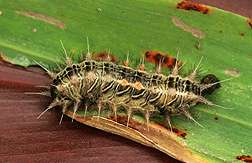Invasive Nettle Moth Triggers Hawaii Research

(PhysOrg.com) -- Like children everywhere, kids in Hawaii love to run barefoot through tall grass. But an invasive pest called the nettle moth caterpillar can take the fun out of this simple childhood pleasure, according to Agricultural Research Service (ARS) research entomologist Eric B. Jang.
The sharp, spiky hairs of the caterpillar, Darna pallivitta, can cause a painful, stinging sensation. Besides being a hindrance to childhood play, this agricultural pest poses a hazard to people working with palm plants and other commercially grown ornamentals that the insect attacks.
That's why Jang, who’s at the U.S. Pacific Basin Agricultural Research Center in Hilo, Hawaii, is working with colleagues in that state and elsewhere to explore new ways to thwart the insect.
In a highly experimental approach, Jang plans to use sexually sterilized fruit flies, such as sterilized melon flies, as winged carriers of an alluring nettle moth scent, a component of what's known as a pheromone. Sterile melon flies are a logical choice because techniques for producing large numbers of them—to disrupt their normal reproduction and cause their populations to crash—are already in place.
In theory, sterilized melon flies, each carrying a drop of the nettle moth chemical on its back, could be set free in moth-infested locales in Hawaii to quickly and inexpensively distribute the scent wherever they fly. Like decoys, the melon flies would create confusion among amorous male moths that use the scent to find female moths.
Jang and colleagues have described the concept and pheromone component in published scientific articles. ARS and the State of Hawaii Department of Agriculture have provided funding to Jang and co-researchers to pursue this innovative idea, known as "mobile mating disruption."
Former postdoctoral research associate Matthew S. Siderhurst identified and synthesized the nettle moth pheromone compound in early experiments funded by ARS and the Hawaii Invasive Species Council.
The pheromone component can also be placed in traps to detect the caterpillar and monitor its spread, Jang noted.
Provided by USDA Agricultural Research Service
















